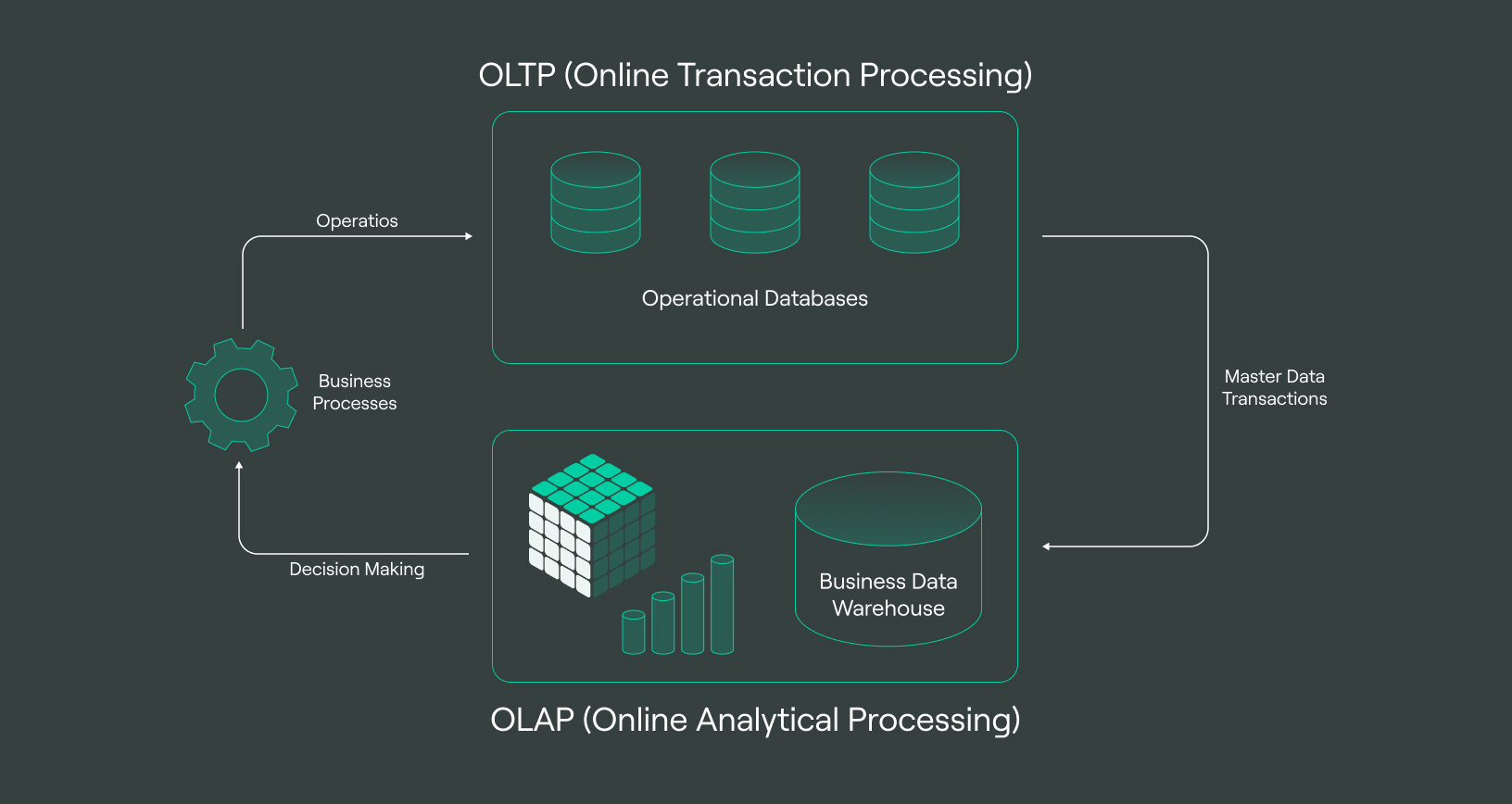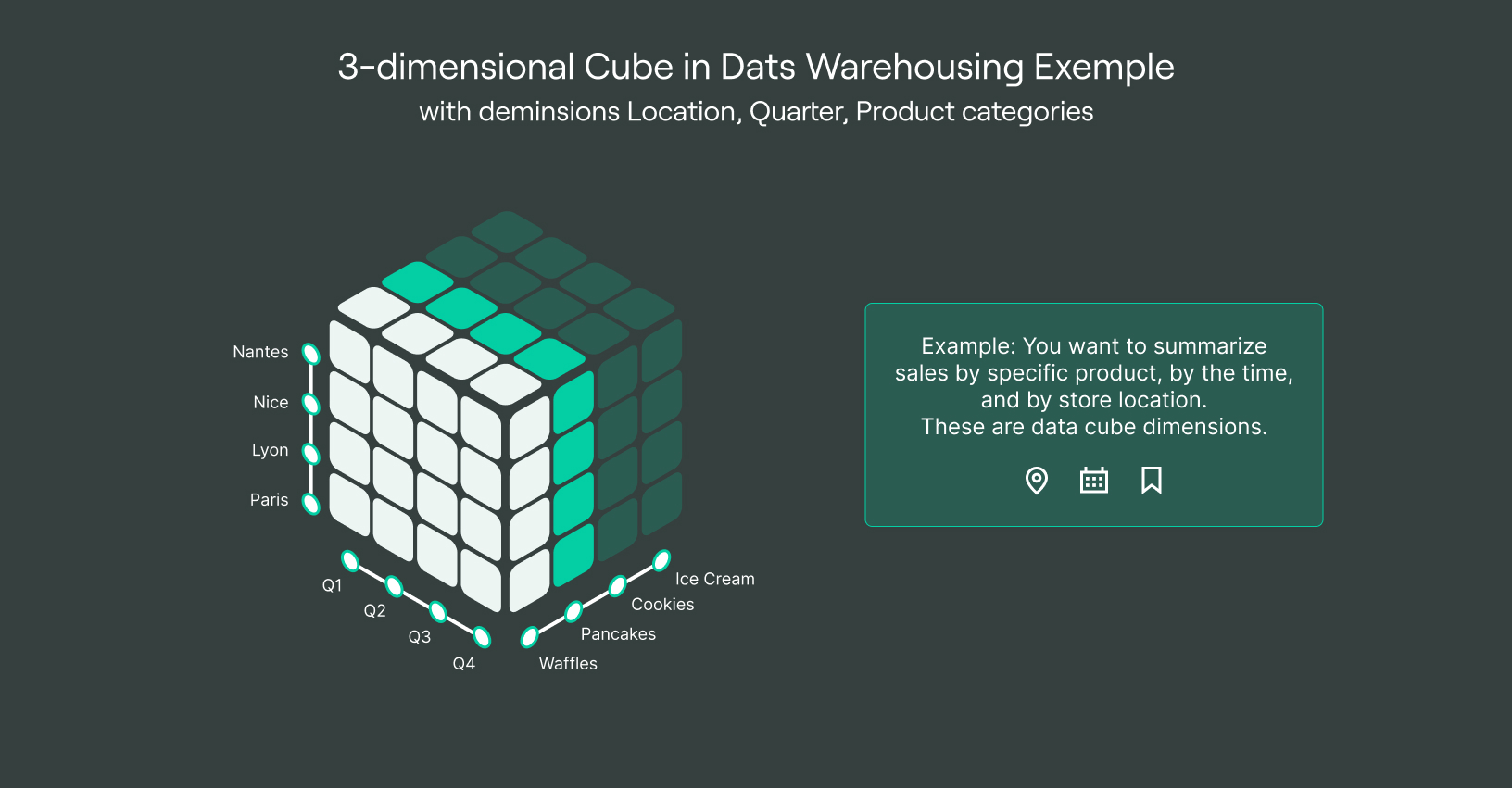
OLTP vs OLAP: What's the right fit for your business needs?
OLTP and OLAP systems are both data processing systems. Each has its own characteristics and executes in a different environment. OLTP systems are initiated for transactional processing in real-time scenarios. These include debit/credit card transactions at a Point-of-Sale (POS) system or funds transfers during online banking.
On the other hand, OLAP systems process data already stored in a data mart or warehouse. Data and business analysts use these for data analysis, forecasting, and creating business reports. OLTP vs OLAP — Let’s discuss what is what.
What is OLTP?
An Online Transaction Processing (OLTP) system captures and processes real-time data transactions. Each transaction resides in a relational database as an independent record.
An OLTP system executes the typical insert, update, and delete commands to create new transactions making the query processing relatively simple. However, the system encounters thousands of transactions simultaneously and can withstand and fulfill parallel requests. OLTP systems also verify data integrity by enforcing a binary transaction state. Database records are only updated when the transaction is complete. If there are any errors or complications, the transaction is canceled and all changes are reverted.
Common applications of OLTP database include:
-
Online transactions: Payment at e-commerce stores or subscription-based services
-
Online bookings: Booking online tickets for cinema, bus, or airline
-
General record keeping: Health records in an EMR or personal records in a government registry
What is OLAP?
The Online Analytical Processing (OLAP) system is tightly linked to business analytics use cases. Applications in production for several years usually have data aggregated in data warehouses, marts, and lakes.
OLAP utilizes this data and business intelligence tools to generate insights that aid business leaders in making important decisions. It stores data in a structure called the OLAP cube. This cube stores data in a multi-dimensional format where each dimension represents a different business aspect.

In this article, we’ll talk about:
- What is OLTP?
- What is OLAP?
- Why is it important to know the difference between OLTP and OLAP?
- OLTP vs OLAP: Side-by-side comparison
- Are there any similarities between them?
- What are the pros and cons of OLTP?
- What are the pros and cons of OLAP
- OLTP vs OLAP: Which is best for you?
- OLTP vs OLAP — Key takeaways
A good OLAP system focuses on optimizing the query logic and building indexes to improve performance and reduce running times. Since they carry out all processing on historical data, OLAP systems utilize batch processing rather than real-time execution. They often involve the execution of complex queries that combine information from various data sources to generate views and analytics.
Some common OLAP database use cases include:
-
Business growth analysis: Year-on-year growth and performance review
-
Revenue forecasting: Forecast business and revenue growth in coming years
Why is it important to know the difference between OLTP and OLAP?
OLTP and OLAP are very distinct systems and fundamentally different in the data type they process. While OLTP executes basic database queries for real-time record processing, OLAP focuses on executing complex logic on large volumes of historical data.
Understanding these differences allows business and technology leaders to choose the correct infrastructure for their respective needs. For example, OLTP requires a system capable of executing multiple queries in parallel and in the shortest time possible. On the other hand, OLAP requires high-performing machines that can handle large multidimensional data. These differences help businesses plan their IT requirements and prevent unnecessary expenditures.
Moreover, both systems also differ in their query execution structure. OLTP modifies production databases and is designed with a fail-safe logic, while OLAP focuses on query optimization to perform complex analytics. Having correct logic in place ensures each system performs efficiently and as expected.
OLTP vs OLAP: Side-by-side comparison
To further understand the key differences between the two systems, let’s analyze their various aspects.
|
OLTP (Online Transaction Processing) |
OLAP (Online Analytical Processing) |
|
|
Purpose |
Execute business-related transactions in real-time |
Analyze data to extract insights, reports, and forecasts |
|
Characteristics |
Execute basic commands across a large number of transactions |
Execute complex logic on a large volume of data |
|
Table |
Contains many tables in an organized fashion |
Fewer tables containing data in bulk amount |
|
Data volume |
Depends on the nature of the business but usually does not go beyond a few million records |
Large data warehouses with billions of records and petabytes of historical data |
|
Data Structure |
Designed for fast processing and remove redundancy |
Built by integrating multiple data sources |
|
Quality of data |
High data quality maintained |
Data mostly present in raw form |
|
Performance |
Almost instantaneous processing of queries |
Depending on data size, execution can take several hours |
|
Users |
Application end-users (POS salesmen, debit card holders etc.) |
Data analysts, machine learning and finance teams |
|
Maintenance |
System should remain highly available and responsive to support transactional workload |
Maintain historical records for long periods and ensure information is accurate and updated |
|
Hardware requirements |
Average storage requirement with multicore CPUs for parallel record processing |
Large volumes of storage and RAM to accommodate data volume |
|
Schema design |
A normalized schema with multiple interrelated tables |
A denormalized structure |
|
Database size |
Gigabytes (Sometimes Terabytes for large enterprises) |
Terabytes and can go up to Petabytes |
|
Data retrieval |
Records are retrieved by joining normalized tables based on their foreign keys to get accurate results |
Queries search through a sea of several million records to retrieve appropriate information |
|
Application |
Modifying online production databases with transaction data |
Analysis on historical data for insights and forecasting |
|
No. of users |
Thousands at a time |
Only a few users (usually in tens) |
|
Audience |
Market-oriented |
Customer-oriented |
|
Backup and recovery |
Frequent backups of the entire database as well as incremental backups |
Backup is not necessary however, it may be taken from time to time |
|
Data integrity |
Must maintain data integrity constraint |
Ensuring data integrity is not critical as the database is not frequently updated |
|
Data source |
Realtime online transactions |
Multiple OLTP databases that have been gathering data for a long time |
|
Operations |
Both read and write operations carried out |
Mostly read operation executed |
|
Productivity |
Improves user experience and productivity |
Improves business operations and processes |
|
Queries |
Execute operations like insert, update and delete |
Complex queries involving complicated aggregations and joining multiple tables |
|
Usefulness |
Used for running customer-facing business applications |
Helps with critical business-related decision making |
|
Challenge |
System infrastructure should be robust enough to handle thousands of transactions simultaneously |
Handling high volume data requires high level of technical expertise |
|
Task |
Carry out business operations |
Aid business analytics |
Are there any similarities between them?
Despite their differences, OLTP and OLAP are data processing systems critical for business operations. Both systems primarily use SQL, are developed by experts with overlapping technical skills, and are connected by a well-constructed ETL pipeline.

It is vital to emphasize that both systems have some similarities at the core. This asserts that both ultimately serve the same purpose, i.e. driving business value and revenue growth hence none should be prioritized over the other.
What Are the pros and cons Of OLTP?
OLTP presents a series of benefits and challenges. Let’s talk about these below
Pros
-
High availability: Ideally, OLTP systems deliver 100% uptime.
-
Fast response: Executes transactions Instantaneously.
-
Highly secure: Since transactions may contain the user’s private or confidential information, OLTP uses methods like user authentication and encryption to secure the executions.
Cons
-
Increased complexity: The system becomes complex when multiple users simultaneously read and write to a database. This increases the chance of congestion and errors.
-
Critical downtimes: Hardware failures can affect transaction processing and user experience.
What are the pros and cons of OLAP
An OLAP system also carries its own merits and demerits. These are discussed below.
Pros
-
Centralized data store: An OLAP data warehouse aggregates enterprise-wide data under one roof.
-
Efficient business analytics: Aggregated data mitigates problems developed by data silos and allows various teams to access all sorts of data. Teams can use this data for sales forecasting, financial reporting, and complex data analysis.
-
Security protocols: Administrators can set user-level restrictions to protect sensitive information.
-
Complex analytical calculations: OLAP databases execute complex queries that process millions of rows to aid business decision-making.
Cons
-
Technical expertise required: OLAP systems require professionals with big data analytics and management expertise.
-
Time-consuming processing: Query execution can take up to hours due to the large data dimensions.
-
Team collaborations: Aggregating and maintaining company-wide data requires collaboration between teams which can be challenging.
OLTP vs OLAP: Which is best for you?
The choice between the two systems depends on your business needs. It is best to compare the characteristics of each system with your development requirements and then draw a conclusion.
OLAP fulfills a business’s analytical requirements and provides insights for financial analysis that help with decision-making. You should consider an OLAP if
-
You possess a large volume of historical data
-
Processing times are not an issue
-
The purpose is to generate reports and forecasts
-
Enterprise-wide data is stored in centralized data stores
It is also important to note that OLAP data requires higher technical expertise due to the complex query logic. You might need to employ experienced data scientists and engineers when opting for an OLAP database.
An OLTP system, on the other hand, is an online database modifying system and ideally fits in scenarios where:
-
Transactional data is processed in a low-latency environment
-
Transactions perform simple actions like insert, update, and delete
-
Data integrity is important
-
Transactions are conducted by several thousand users in parallel
If your application involves user interaction and fits on the above-mentioned points, then OLTP is the right choice for you.
Moreover, since both systems serve different purposes for the same data, most organizations implement both to gain the most from their data. OLTP handles transactional processing for end users and collects and stores data across multiple database systems. This data is then aggregated by OLAP and used to drive report creation and business decision-making.
OLTP vs OLAP — Key takeaways
OLTP and OLAP facilitate data processing within an organization however, each operates under a unique paradigm. OLTP handles transactional queries involving basic operations, while OLAP focuses on processing terabytes of warehouse data.
Each system has its characteristics, making them perfect for their designated job. OLTP specializes in handling multi-user queries involving several thousand read-and-write operations to the database. OLTP systems are highly available and maintain data integrity and security as a top priority.
OLAP focuses more on the bulk processing of historical data. It reads millions of rows stored in data marts, warehouses, or lakes and processes them using complex queries. OLAP queries mostly read all the required data in only a few operations; however, further processing can take up to a few hours.
Depending on their use case, organizations may choose to deploy only one or both procedures. However, both systems are vital in streamlining data-related processes and enabling business growth.
Frequently asked questions (FAQ)
Can OLAP and OLTP systems be used together?
Can OLAP and OLTP systems be used together?
Yes, both systems can be used together. OLTP processes transactional data and stores it over time across multiple databases. OLAP then accesses this data and uses it for analytics.
Which is better, OLAP or OLTP?
Which is better, OLAP or OLTP?
Is data warehouse OLAP or OLTP?
Is data warehouse OLAP or OLTP?
What are some common use cases for OLAP and OLTP systems?
What are some common use cases for OLAP and OLTP systems?
Get started for free



